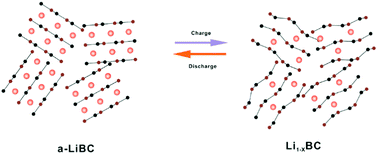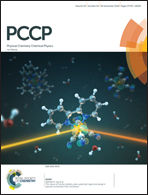Crystallinity-dependent capacity of a LiBC anode material in Li-ion batteries†
Abstract
LiBC is a layered boron carbide material that was first studied as a superconducting material. Theoretical study showed that LiBC is a promising cathode material in Li-ion batteries, while our early computational and experimental studies demonstrated the feasibility of LiBC as a high-capacity anode material for Li-ion batteries. In this work, LiBC has been synthesized by a solid-state method using different carbon precursors of acetylene black and graphite, marked a-LiBC and g-LiBC, respectively, and their electrochemical properties and corresponding structure evolutions have been investigated in Li-ion batteries. As a result, a-LiBC delivers a higher specific capacity than g-LiBC, 500 mA h g−1vs. 200 mA h g−1, after 50 cycles at a rate of 0.1C. Actually, a significant structural evolution of a-LiBC was observed by in situ XRD during the charge/discharge processes, while a nearly constant structure was detected for g-LiBC. Meanwhile, in situ Raman results revealed the evolution of vibrational beating modes at different charge/discharge states. Therefore, the specific capacity of LiBC is closely related to its crystallinity, and LiBC with amorphous carbon precursors could be adopted as a promising anode material for Li-ion batteries.



 Please wait while we load your content...
Please wait while we load your content...